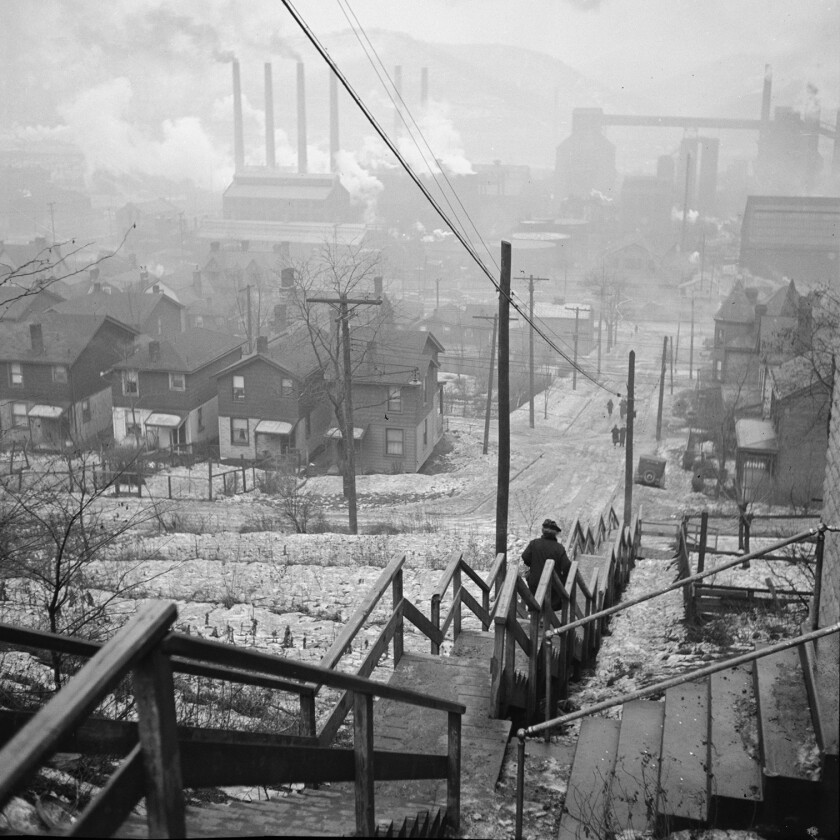
Photographs by David Kidd
Depending on who you ask, there are anywhere from 800 to 1,165 sets of city steps in Pittsburgh. Public Works likes to break them up into manageable sections, which adds to the count.
Matthew Jacob, once a Public Works employee, now works in the Department of Innovation and Performance, where the steps are still in his purview. When he purchased his home in the South Side Slopes neighborhood, proximity to the public steps was a major selling point. “It’s a very hilly neighborhood,” he says. “There are a LOT of steps up here.” His 30-minute walk to work begins on the sidewalk steps outside his front door, continuing down several flights along the route. Matt is not alone in commuting to work on foot. But foot traffic on the steps today is much less than what they were designed for.
A Way to Get to Work
With abundant natural resources and navigable waterways, Pittsburgh was ideally suited for the iron, steel and glass factories that flourished along its flat riverbanks in the late 19th and early 20th centuries. The only land available to house most of the workforce was high up in the hills, overlooking the mills. In order to get workers to their jobs, a network of steps was built into the steep slopes, first of wood, then of concrete. A steelworker would descend from his hillside home in the morning and then labor for 12 hours under brutal working conditions. Covered in sweat and soot, he climbed back up at night, six days a week.
Often described as Pittsburgh’s first transportation system, public steps can still be found in 66 of the city’s 90 distinct neighborhoods, connecting people to businesses, schools, church and each other. City resident Christine Tripoli remembers a time when the steps were often the only option to get around. “Until recently, people might only have one car per family. So, the dad went to work and everybody else used the steps. Because the trolley cost money.”

(Jack Delano/Library of Congress)
Eighty-two-year-old Father Richard Malepa, a priest at the St. Paul Monastery, is less inclined to take the stairs these days. “We raced up the steps to go to school,” he says. “We’d swing down the whole five steps. When you’re a kid you can do that.” A scar is still visible over Father Richard’s eye, the result of a collision with a telephone pole at the bottom of some steps.
One Man’s Quest to Count the Steps
Not much more than two decades ago, no one knew how many steps there were in the city, their condition or their location. Until one man made it his mission to find out. Bob Regan moved to Pittsburgh 30 years ago, where he continued his work with mapping software. An avid bike rider then and now, he soon became aware of the many public stairways in his adopted city. Pittsburgh, he learned, did not keep records of this important local infrastructure. The city could account for only about 100 sets of steps. Bob considered mapping the steps himself, but the need to focus on work and family left him with little time for an outside project.

Out on his bike each morning at five, Bob Regan spent the summer of 1999 in search of city steps. Riding every street and stopping at every set of stairs, he made note of the location of both the top and bottom of every set, the number of steps, tread width and method of construction. In the course of his survey, Bob rode his bike down nearly 2,000 miles of Pittsburgh streets, methodically covering every neighborhood, section by section. Home before 10, the rest of his day was spent mapping what he had found, first on paper, and then on a computer. He also built a database to keep track of his findings. Rainy days were spent checking for errors and discrepancies.
All told, Bob identified 712 sets of city steps. But he continued to find more, mostly from tips offered by other enthusiasts. “They would call and say, ‘Have you seen the steps at such and such a place?’ and I would say ‘What steps? Oh! I’d better go check that out.’”

Bob’s work was also made available to the public as a book, The Steps of Pittsburgh, which is since out of print. “People from all over the world were ordering it,” he says. “I have two copies. I wish I had more.” A decade later he wrote a second book, Pittsburgh Steps, The Story of the City’s Public Stairways, which updates and expands on the earlier volume.
A Personal Attachment to the Steps
“This book is really disgusting,” says Laura Zurowski, clutching a beat-up copy of Bob Regan’s second book. “It’s so dirty.” Laura is a Pittsburgh writer and photographer and, like Bob, Pittsburgh is her adopted home. She is using Bob’s second book as inspiration for a steps-focused project of her own. “This is a book that has been in my hands every single day for five years. This is what a book that you touch every day looks like.” Bob gave Laura a clean copy last year, but that one sits at home on a shelf.

Anxious to share her affection for Pittsburgh and its stairways, Laura regularly leads weekend tours of neighborhood steps. A recent overcast Saturday found her with a group of 30 and a rambunctious Bernese Mountain Dog. “This is not a race,” she says at the base of the first flight up. “Nobody gets left behind. Hold on to the handrails and take your time.” She stops for a few minutes at the top and bottom of every set of steps, dispensing a bit of history about the city and its infrastructure.
Matthew Jacob has also come to view the steps as something more than a way to get around. He, too, visits the steps on his own time, takes pictures and posts them to a personal Instagram account. “I came to find them really cool and really unique,” he says. “So it became more of a personal passion or hobby of mine as well.”

Claiming to be retired now, Bob still teaches two courses a year in database design and geographic information systems at the University of Pittsburgh. “I ride my bike or walk every day,” he says. The city steps continue to be a big part of his life. “There’s one set in particular that I try and do several times a week. Ninety-one steps.”
Building on the Past
At 371 steps, Rising Main Way is the fourth longest stretch of steps in Pittsburgh. In days past, workers used them to descend from their homes in the Fineview neighborhood to jobs in the valley below. But today, the only thing at the bottom of the stairs is an interstate highway and a century-old pumping station. A handful of houses still exist near the pump house, but most of them have been abandoned. Once a necessary and popular means of getting around, this set of steps is rarely used anymore. “This leads to questions of preservation of a flight like this,” says Laura. “Because there’s only a few people who live here. There’s nothing to walk to.”


Gone, but Not Forgotten
At the start of her Saturday walking tour, Laura stands beneath the concrete piers of a particularly tall set of steps. “I always like to give a shout out to my brothers and sisters in Public Works,” she says. “Every flight of stairs is unique because the landscape is always different. They had to design them. People had to come out and build them. And those people, many of them, they’re long gone and forgotten. But the quality of their craftsmanship is astounding, because 70-80 years later… the steps are still here. It speaks back to a bygone era when things were constructed in a different way.”
Longtime resident Christine Tripoli takes personal pride in Pittsburgh’s steps. “I think a lot of that stems from why the stairs are here,” she says. “The memory of those steel workers, walking back up those stairs, at the end of a day, when they were working six days a week and 12 hours a day.”












